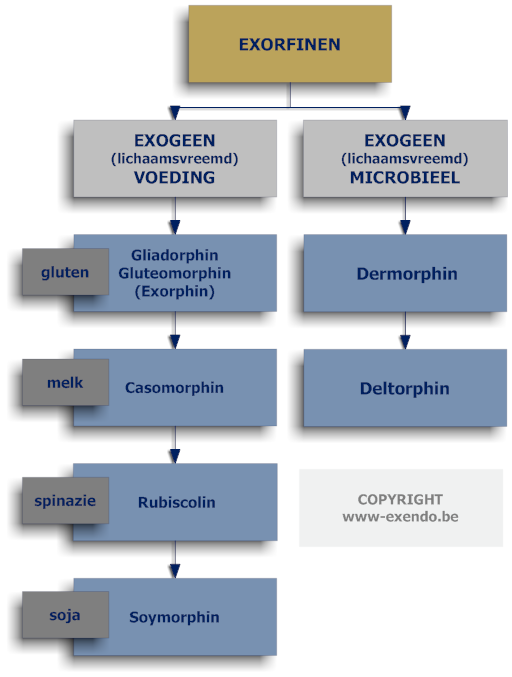Exorphin research
'Click here' to order the exorphin test (gluten and casein).
Michael van Gils (therapist) and An van Veen (physician) the Dutch endorphin pioneers worked for years with a reliable exorphin test from the company Exendo. The test, although expensive for many patients, was very reliable due to its high sensitivity. Unfortunately, the Exendo company stopped the exorphin tests over a year ago.
Now there are several laboratories offering exorphin tests but they appear to be much less sensitive by comparison.
Exorphins are morphine-like proteins (peptides) that the body does not produce itself. In food, exorphins are found in milk protein (casein), soy, spinach and gluten.

These exorphins can cause both psychological and somatic symptoms when you lack the enzymes to break them down.
The breeding of our wheat has caused the percentage of exorphins to increase tremendously compared to 100 years ago. The same has occurred with milk; the earlier breeds, such as the Friesbonte cow or the Jersey, had a much smaller amount of exorphins in the milk than today's breeds (Frisian Holsteiners).
An exorphin burden is not comparable to an allergy or intolerance. However, an allergy or intolerance can be the result of an exorphin problem. An exorphin load first causes a less sensitive endorphin system and eventually even the endorphin receptors are removed from the cells (epi-genetic acquisition). 'Click here' for an explanation of the endorphin system.
Food exorphins are classified by origin (gluten, casein, soy, spinach and fungi).
The new test, measures only the main exorphins, those from gluten and cow's milk. Within these 2 types, there are different exorphins subclasses, each with different (side) effects:
Casein
- B-casomorphins (caseins) are highest in women with postpartum psychosis R (postpartum psychosis). Too high concentrations from cow's milk can cause intestinal colic R (crying babies) or crib death R. There appears to be a relationship between the amount of exorphins found in lactating mothers and immune problems in themselves and their child. Mothers with the highest exorphins load have more allergies R. Their baby is significantly more likely to have allergies R and asthma R. Casomorphins slow the production of TSH R, this hormone stimulates the production of the T3 and T4 thyroid hormones. This could explain why people with a high casomorphin load are more likely to suffer from delayed thyroid function.
- B-casomorphin 1-4 amide or morphiceptin (casein) acts as an endorphin antagonist on the vas deferens (rats) R. Antagonists block the receptors of a particular signaling substance (e.g., endorphin or dopamine), preventing its activation. One of the consequences of a high morphiceptin load is possible infertility (few sperm cells).ß-casomorphin 1-4, amide (morphiceptin) is 100 times stronger than endomorphin and as strong as morphine in brain R. Morphiceptin is thus the strongest milk exorphin. In comparison, ß-casomorphin-4 and ß-casomorphin-7 are 8 and 20 times weaker than morphiceptin, respectively.
- B-casomorphin-7 is a serotonin antagonist R (turns off serotonin) and causes more release of histamines (humans) R than classical (IgE) allergies. This can give rise to pseudo-allergic skin rashes R. In humans, it causes an increase in mucosal formation, including in the respiratory tract R. Children with a B-casomorphin-7 load are more likely to have delayed psychomotor development R1 . In rats, it decreases mother-child bonding R and increases stomach acid by 52% R. Both B-casomorphin 5 R and 7 R can cause crib death in infants R. In 1999, the University of Florida published a study confirming the link between BCM-7, autism and schizophrenia (for the umpteenth time) R. In 2003 R and 2010 R, Dr. K. Reichelt and Dr. R. Sacoo came to the same conclusion.
- B-casomorphin-5 causes improved memory in (rats) low doses, but memory loss R at high doses. In humans, it can give rise to apnea R. The degradants of B-casomorphin-5 block the action of the DPP-IV enzyme Rwhich renders the enzyme unusable for other functions. B-casomorphin-5 is ten times more potent than the same amount of morphine R.
- B-casomorphin-8 is an ACE inhibitor; it inhibits the angiotensin I converting enzyme R (ACE). ACE inhibitors cause itchy cough, low blood pressure, hyperkalemia, dizziness, rash and itching.
- Exorphins(gluten): Dr. Curtis Dohan showed as early as 1988 that the increase in psychosis and schizophrenia correlated with the increase in dietary gluten exorphins R. In 1990, Dr. Karl Reichelt did a remarkable study: he cured all patients with schizophrenia and psychosis by putting them on an exorphins-free diet for two years R.
- Exorphin-C acts as an endorphin antagonist R,
- Exorphin A5 decreased pain threshold in psycho-social conflict in mice R.
- Exorphin B5 acts as a dopamine antagonist R .
Source: Exendo

